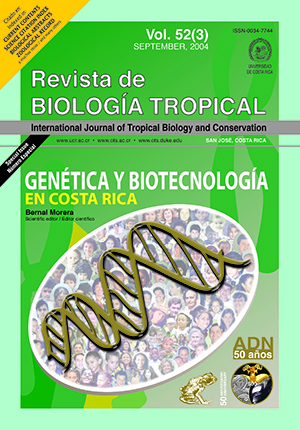Abstract
The purpose of this work was to determine if the occupational exposure to those pesticides used at banana plantations’ packaging plants produces genetic damage to somatic cells of female workers. Chromosomal aberrations were scored in lymphocytes of 20 women, 10 female exposed workers and 10 female controls. Workers were recruited from independent farms from two locations in Costa Rica, during January through June in 1996 and 1997. These females had a minimum of three months of work, had never received chemotherapy or radiotherapy and did some of these labors: sealing, spraying or weighting of bananas. Control unexposed females lived in the same area, were of similar age and neither them nor their husbands/mates had ever worked in pesticide related labors. For each female, 100 mitotic figures were scored. The kind of aberrations detected were acentric fragments, dicentric chromosomes, rings, gaps and breaks. Among workers, 16% of cells (n=1000) had one or more abnormalities, whereas control unexposed females had 6% of cells (n=1000) with comparable anomalies (p<0.05). In conclusion, the pesticide exposure is a risk factor for chromosome aberrations in female somatic cellsReferences
Anónimo. 1994. Occupational cancer in developing countries. IARC Scientific. Publications N°129. Lyon. 191 p.
Ashby, J., W. Angbar, W. Au, A. Massoud & J. Gentile. 1993. Genetic Toxicology in Developing Countries: Comments and recommendations. Environ. Health Perspect. 101: 335-338.
Au, W. 1991. Monitoring human populations for effects of radiation and chemical exposures using cytogenetics techniques. Ocupational Med. 6: 597-611.
Au, W., D.M. Walker, J.B.Ward, E. Whorton, M.Legator & V. Singh. 1991. Factors contributing to chromosome damage in lymphocytes of cigarette smokers. Mut. Res. 260: 137-144.
Au, W. & R. Sram. 1996. Second International Conference on Environmental Mutagens in Human Populations. Environ Health Perspect 104 (Suppl 3): 421-422.
Au, W., C.H. Sierra-Torres, N. Cajas-Salazar, B.K. Shipp & M. S. Legator. 1999. Cytogenetic effects from exposure to mixed pesticides and the infkuence from genetic susceptibility. Environ. Health Perspect. 107: 501-505.
Bonassi, S. & W.W. Au. 2002. Biomarkers in molecular epidemiology studies for health risk prediction. Mutat. Res. 511: 73-86.
Carrano, A.V. & A.T. Natarajan. 1988. Consideration for population monitoring using cytogenetic techniques. International Commision for Protection against environmental mutagens and carcinogens. Publication No 14. Mut. Res. 204: 378-406.
Castro, R., V. Ramírez & P. Cuenca. 2004. Análisis de micronúcleos y otras anormalidades nucleares en el epitelio oral de mujeres expuestas ocupacionalmente a plaguicidas. Rev. Biol. Trop. 52: 207-217.
Cuenca, P. & V. Ramírez. 2004. Mutagénesis ambiental y el uso de biomarcadores para predecir y prevenir el riesgo de cáncer. 52: 181-186.
Dulout, F.N., M.C. Pastori, A.O. Olivero, M. González Cid, D. Loría, E. Matos, N. Sobel, E.C. de Buján & N. Albiano. 1985. Sister-chromatid exchanges and chromosomal aberrations in a population exposed to pesticides. Mut. Res. 143: 237-244.
Fear, N.T. 1998. Childhood cancer and paternal employment in agriculture: the role of pesticides. Br. J. Cancer 77: 825-829.
García, J. 2003. Plaguicidas: Problemática y opciones de solución, con énfasis en Costa Rica. Foro Latinoamericano. Acta Académica 33: 33-52.
Hagmar, L., A. Brogger, I.L.Hansteen, S. Heim, B. Högstedt, L. Knudsen, B.Lambert, K. Linnainmaa, F. Mitelman, I. Nordenson, Ch. Reuterwall, S. Salomaa, S. Skerfving & M. Sorsa. 1994. Cancer risk in human predicted by increased levels of chromosomal aberrations in lymphocytes: Nordic Study Group on the Health Risk of Chromosome Damage. Cancer Res. 54: 2919-2922.
Hagmar, L., S. Bonassi, U. Stromberg, A. Brogger, L. Knudsen, H. Norppa, C. Reuterwall & The European Study Group on Cytogenetic Biomarkers and Health. 1998. Chromosomal aberrations in lymphocytes predict human canmcer: A report from the European Study Group on Cytogenetics Biomarkers and Health (ESCH). Cancer Res. 58: 4117-4121.
Hernández,O. & R.L. Bolaños. 1993. SPSS/PC + básico. Editorial de la Universidad de Costa Rica. San José, 249 p.
Nordenson, I., L.Beckman, S. Liden & N. Stjernberg. 1984. Chromosomal Aberration and Cancer Risk. Hum. Hered. 34: 76-81.
Pearce, N., E. Matos, H.Vainio, P. Boffetta, M. Kogevinas (eds.). 1994. Occupation cancer in developing countries. IARC Scientific Publication. Lyon, 141 p.
Preston, R.J. 1999. Chromosomal changes, pp. 395-408. In D.B. McGregor, J.M. Rice & S. Venitt. (eds.). The use of short- and medium-term test for carcinogens and data on genetic effects in carcinogenic Hazard evaluation. IARC Scientific Publications N° 146. Lyon.
Ramírez, A.L. & C.M. Ramírez. 1980. Esterilidad masculina causada por la exposición laboral al nematicida 1,2-Dibromo- 3 Cloropropano. Act. Méd. Cost. 23: 219-222.
Ramírez, V. & P. Cuenca. 2001. Micronuclei frecuency in lymphocytes of individuals occupationally exposed to pesticides. Rev. Biol. Trop 49: 1-8.
Ramírez V. & P. Cuenca. 2002. Daño del ADN en trabajadoras bananeras expuestas a plaguicidas en Limón, Costa Rica. Rev. Biol. Trop. 50: 507-518.
Savitz, D.A., N.L. Sonnenfeld & A.F. Olshan. 1994. Review of Epidemiologic Studies of Paternal Occupational Exposure and Spontaneous Abortion. Am. J. Industrial Med. 25: 361-383.
Sorsa, M., J. Wibourn & H. Vainio. 1992. Human Cytogenetic damage as a predict of cancer risk, pp 543-544.
In Vainio, H., P.N. Magee, D.B. McGregor & A.J. Mc Michael (eds.). Mechanism of carcinogénesis in risk identification, IARC Scientific Publications, Lyon.
Vaquerano, B. 2001. Establecimiento de controles normativos (restricciones y prohibiciones) a los plaguicidas sintéticos. Memoria del foro sectorial: “El uso de plaguicidas y su relación con el desarrollo en Costa Rica”. Proyecto PLAGSALUD, OPS / OMS, Rel- UITA, Foro Emaús. San José, 66 p.
Wesseling, C., A. Ahlbom, D. Antich, A.C. Rodriguez & R. Castro. 1996. Cancer in banana plantation workers in Costa Rica. Int. J. Epidemiol. 24: 1125-1131
##plugins.facebook.comentarios##

This work is licensed under a Creative Commons Attribution 4.0 International License.
Copyright (c) 2004 Revista de Biología Tropical


